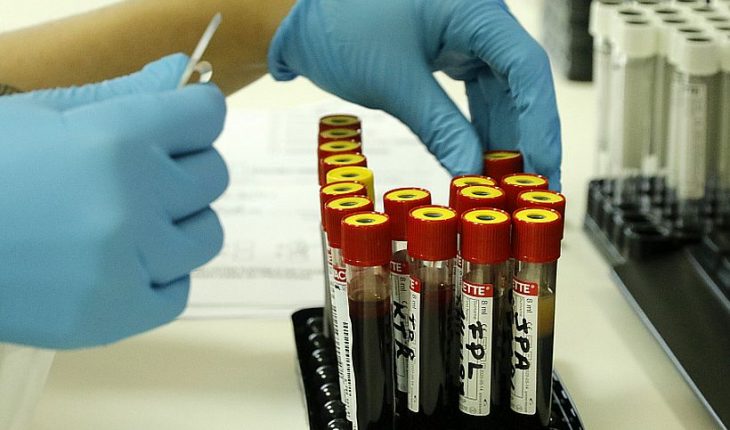The ICOVID Chile team, an initiative led by the University of Chile, the Pontificia Universidad Católica de Chile and the University of Concepción, presented its 53rd report with analysis and data of the dimensions proposed to monitor the pandemic in the country, with information obtained until Saturday, August 7, 2021, provided through an agreement with the Ministry of Health and the Ministry of Science, Technology, Knowledge and Innovation.The latest report shows that at the national level, the level of load was 4.8 new cases per 100 thousand inhabitants, yellow color in the ICOVID Chile traffic light, and 13% less than the load of the previous week. This decrease is smaller than that calculated in the previous report in relation to the previous week (August 31), confirming a slowdown in the reduction of the load. Meanwhile, at the regional level, this dimension remains in red specifically in the regions of Arica and Parinacota (12.3), Tarapacá (11.4) and Los Ríos (10.4). Likewise, the number of regions in orange is 11, with values between 5.0 and 9.9 per 100 thousand inhabitants, and only two in yellow, Coquimbo and O’Higgins. On the other hand, the report details that the transmission rate (effective R) at the national level rose from 0.89 to 0.91. Although this value is still less than 1 this week’s dynamic increase, just like the previous week, “it’s a sign of concern. Thinking especially about a possible resurgence caused by the Delta variant,” the report details. In addition, six regions with R in red and four with this indicator above 1.2 are reported: Magallanes (1.5), Aysén (1.3), Antofagasta (1.4) and Tarapacá (1.2). Which is a worsening with respect to the previous week, where only three regions were shown in the red, and the highest was 1.2.In fact, Alejandro Jofré, pro-rector of the University of Chile, emphasized that “an improvement in the indicators continues to be observed. However, I call attention to a slowdown in the reduction of the load. This is important to observe closely, given an eventual outbreak caused by the Delta variant of the virus. This situation would be critical, if we add the data that six regions still show high rates of ICU bed occupancy.” For his part, Guillermo Marshall, pro-rector of the Pontifical Catholic University of Chile stressed that “the reduction in the number of new cases of COVID-19 in Chile is maintained for the ninth week, a reduction that in the last three weeks has been around 15% weekly. For its part, the reduction in the number of deaths that began five weeks ago is ratified, and that is in line with the reduction in the number of new cases.” Regarding the total number of PCR tests reported per thousand inhabitants, it has stabilized during the last weeks around 17 at the national level. Meanwhile, at the local level, there is an important heterogeneity, with rates greater than 30 in Arica and Parinacota, Atacama, Aysén and Magallanes; while figures less than 15 in the Metropolitan Region (with the lowest figures) and O’Higgins. On the other hand, the positivity of the PCR tests continues to decline, with an average of 1.89% in the last measurement. The regions with high testing rates show the lowest positivity (for example, 0.66% in Magallanes and Aysén), in contrast to the Metropolitan Region that reaches 2.5% The only region that, although also observed to the downside, is not yet in green in this indicator, is Los Ríos, with a positivity of 3.3%. In the traceability dimension, the early consultation indicator recorded a value of 54.3% at the national level. At the regional level, the lowest values are observed in Magallanes (42.3%), Los Ríos (47.6%) and La Araucanía (49.5%). “Magallanes’ situation is worrying, given that it may denote that, in regions where epidemiological results have improved, the population’s awareness of the need for early consultation in the face of suspicious symptoms deteriorates,” warn ICOVID experts Chile.La proportion of laboratory tests reported to the Ministry of Health in a day or less from the date of sampling, reached 82.3% nationally in the last available week, maintaining a clear upward trend since the end of March, when its value was close to 55%. Practically all regions are over 80%, worrying only the situation of Tarapacá with 62.4% of the tests reported before 24 hours. With regard to the dimension of hospital capacity, the new report shows that the occupancy of ICU beds nationwide stabilizes at the threshold between red and orange, reaching 85%. Meanwhile, at the local level, nine regions show an increase in the occupancy of total ICU beds, highlighting the largest in the regions of Arica and Parinacota and Valparaiso. In fact, Valparaiso is the only region that has an occupation greater than 90%, reaching a very critical level this week with 96%. Meanwhile, Tarapacá, O’Higgins, Ñuble, Aysén and Magallanes have the lowest occupations (less than 70%)On the other hand, the use of ICU beds by patients with COVID-19 continues with a clear trend of reduction, decreasing from 46 to 36% compared to the previous week of analysis. At the regional level, meanwhile, Tarapacá, Ñuble, La Araucanía, Los Lagos, Los Ríos and Magallanes show a proportional increase in COVID-19 patients in their ICUs compared to the previous week. However, “this should be interpreted with caution since a decrease in ICU beds or a greater delay in the recovery of non-COVID-19 hospital activity in some regions could explain these changes,” the specialists note in the report. Meanwhile, with respect to the weekly rate of change in COVID-19 hospitalizations, which measures the trend in the daily use of hospital beds of all types (basic, intermediate, ICU, ICU) by COVID-19 patients, the new report indicates that the exponential drop in total COVID beds in the previous month stabilizes in a linear drop with a speed of approximately -15%. On the other hand, on the indicator of average daily hospitalizations of COVID patients in ICU beds differentiated by age, the report reports that the decrease in the daily use (stock) of ICU beds due to COVID-19 is maintained in all age groups. However, he points out that the decrease in age groups under 50 years of age has been significant in recent weeks, reaching today to equal the number of ICU beds used by adults aged 70 and over. With regard to the progress of the vaccination plan, the new ICOVID Chile report indicates that for the week under analysis it has reached 88.0% of coverage of first dose and 74.7% of second dose for population in the range 18-49 years, maintaining a rapid increase in vaccination in this group, related to the advances in vaccination of lagging groups. Meanwhile, for the group between 50 and 69 years and over 70, a similar behavior is observed: 92% of coverage of the first dose and 89% for the second dose, a marginal increase with respect to recent weeks, which demonstrates the difficulty in reaching the un vaccinated groups lagging behind that represent between 8-10% of the population. “It is recommended that in order to reach these groups, targeted strategies and special programs be deployed to increase coverage,” the report states. Also, in terms of population coverage, the country’s average reaches 64.84%, with all regions of the country exceeding 55%. The lowest figures are observed in Arica and Parinacota and Tarapacá, below 60% of population coverage. At the other end, O’Higgins, Ñuble, Aysén and Magallanes with coverages over 70%. With regard to the covid-19 mortality indicator by age group, which groups confirmed and suspected deaths from official data from the Department of Health Statistics and Information, DEIS, in the last week with available data (from 25 to 31 July) 615 deaths from COVID-19 were recorded. “Of these, there were 403 deaths in the 70-plus age group, 159 deaths for the 50-69 age group, and 53 deaths for those under 50. The trend is for clear improvement, with a sustained reduction in mortality for all age groups over the past four weeks,” the report reveals.
translated from Spanish: ICOVID Chile: warn of slowdown in reduction of new cases
August 14, 2021 |





